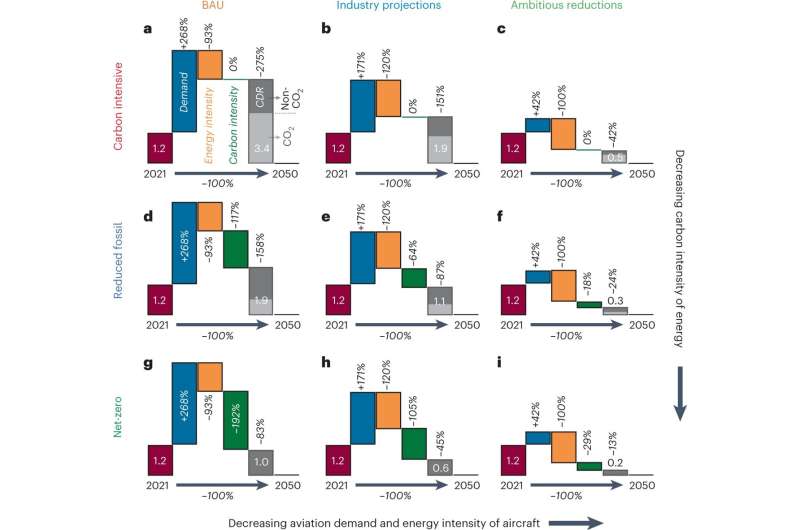Decomposition parameters for changes in emissions in GtCO2eq from 2021 to 2050. Each column represents a combination of demand and energy intensity (De), and each row represents a carbon-intensity trajectory (f). Each panel represents a demand and energy-intensity trajectory combined with a specific carbon intensity (Def). Colors for the headers represent low- (orange/red), medium- (blue) and high-ambition (green), for example, panel a represents the lowest ambition scenario with BAU demand and energy intensity and a carbon intensive fuel mix. Each bar within each panel represents a Kaya parameter: historical emissions in 2021 (maroon), increase in emissions based on projected demand (blue), decrease in emissions based on energy-intensity improvements (orange), potential further reductions due to changes in carbon intensity of energy (green) and carbon dioxide removals (CDR) needed to reach net-zero by 2050 (gray). The CDR gray bar is divided into two, representing the split between CO2 and non-CO2 equivalent emissions in each scenario. Credit: Nature Sustainability (2023). DOI: 10.1038/s41893-022-01046-9
With its high-carbon footprint, air travel challenges the goal set by many countries of stabilizing global mean temperature by the middle of the 21st century. The aviation sector could achieve net-zero carbon emissions by 2050 through a combination of technology and a change in habits, but it's not going to be easy, according to Earth system scientists at the University of California, Irvine.
In a paper published recently in Nature Sustainability, the UCI researchers spotlight efforts that will be necessary for the airline industry to operate more sustainably. Assuming moderate growth in demand for flights over the next few decades, steps that can be taken to curtail aviation emissions include business practice and infrastructure enhancements, more efficient propulsion systems and greatly expanded use of sustainable aircraft fuels, the paper's authors note.
"We are beginning to see a path toward dealing generally with climate change through improved efficiencies, electrification of energy end uses and switching to non-greenhouse-gas-emitting sources of energy," said lead author Candelaria Bergero, UCI Ph.D. student in Earth system science. "But flying will be particularly hard to decarbonize because of its appeal and popularity as a mode of transportation and its reliance on energy-dense liquid fuels."
In the paper, the researchers highlight an important if not immediately obvious factor—the non-CO2 contribution to climate change from air travel. "Planes produce nitrous oxide and an exhaust water vapor trail when they're aloft," Bergero said. "Studies found that this amounts to two-thirds of the climate change-causing radiative forcing that comes with aviation."
She said that non-CO2 effects from contrails will need to be compensated by removing hundreds of millions of tons of direct carbon dioxide from the air, far more capacity than currently exists worldwide. Airline industry leaders who have committed to net-zero carbon operations must either get rid of the carbon on their own or aggressively pursue carbon credits to pay others to accomplish the removal.
The researchers note that eliminating all emissions from air transportation will require a dramatic transition to sustainable aviation fuels. Derived synthetically or through biofuels generation, these fossil fuel replacements are feasible and appealing to industry leaders because they are considered a "drop-in" resource that can be used in existing aircraft—some of which have operational lifespans approaching 50 years—and current fueling infrastructure.
But there are other cost and capacity issues that come with sustainable aviation fuels. The researchers state that the most scalable SAFs are still about four times more expensive than fossil jet fuel today, and a complete replacement in the air transportation sector would gobble up a quantity of fuels equal to all biofuels produced worldwide in 2019.
"Scaling up production of sustainable aviation fuels will entail big investments in new technologies and processes. Demand for biofuels will also be competing with food production for land, even as demand for food also increases in the coming years," said co-author Steven Davis, UCI professor of Earth system science. "But we are optimistic that through targeted innovation, good public policy and corporate climate action, our society can make progress toward achieving net-zero commercial aviation."
More information: Candelaria Bergero et al, Pathways to net-zero emissions from aviation, Nature Sustainability (2023). DOI: 10.1038/s41893-022-01046-9
Journal information: Nature Sustainability
Provided by University of California, Irvine
























